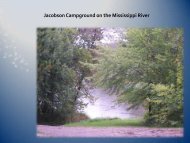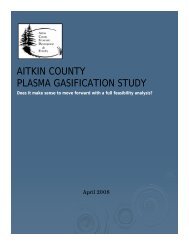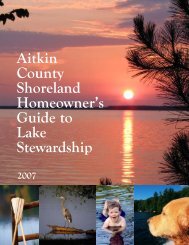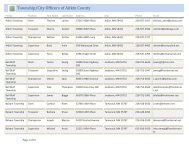• Shoreline erosion due to elevated lake levels can influence water quality bycreating a source for sediment, mercury and phosphorus.“Beneficial uses” are the uses that states decide to make of their water resources. Theprocess for determining beneficial uses is prescribed in the federal rules implementingthe Clean Water Act. Seven beneficial uses are defined in Minn. R. 7050.0200.Drinking water – Class 1Aquatic life and recreation – Class 2Industrial use and cooling – Class 3Agricultural use, irrigation – Class 4AAgricultural use, livestock and wildlife watering – Class 4BAesthetics and navigation – Class 5Other uses – Class 6Limited Resource Value Waters – Class 7.Ground water. Underground waters are protected for just one use, as an actual orpotential source of drinking water. All ground water is designated as Class 1.Surface water. All surface waters, lakes, rivers, streams and wetlands in Minnesota areeither Class 2, protected for aquatic life and recreation, or Class 7, designated asLimited Resource Value Waters. In addition, all surface waters (i.e., both Class 2s and7s) are protected for industrial use (Class 3), agricultural uses (Class 4A and 4B),aesthetics and navigation (Class 5), and other uses (Class 6). Thus, all surface watersare protected for multiple uses.The vast majority of surface waters in Minnesota are Class 2, protected for aquatic lifeand recreation. Some Class 2 surface waters are also protected as drinking watersources and, in addition to the other uses, are designated Class 1 waters. All troutwaters are protected for drinking (even though most are not used for this purpose), andsome Class 2B waters are protected for drinking (designated as Class 2Bd waters).Examples of the latter include portions of the Mississippi River upstream of St. AnthonyFalls, the Red River, and some mine-pit lakes.The Clean Water Act requires States to publish, every 2 years, an updated list ofstreams and lakes that are not meeting their designated uses because of excesspollutants. The list, known as the 303(d) list, is based on violations of water qualitystandards and is organized by river basin. In Minnesota, the MPCA is tasked withcompiling and updating this list.4.4.9 ContaminantsTwo toxic pollutants are of interest within the study area, mercury and PCB’s. TheMPCA lists these as bioaccumulative toxics, which means they accumulate in organismsup the food chain. The MPCA has developed a map of the Headwaters basin (Figure4.4.9.a) that shows impaired water bodies and the contaminant responsible for thatlisting. Most waters are listed as impaired for mercury and a few near the southernHeadwaters ROPE Study 71
portion of the study area are listed for PCB’s. Mercury is introduced to most aquatichabitats in the study area via atmospheric precipitation rather than through immediatelyadjacent industrial or geological sources. The occurrence of mercury in its toxic methylmercuryform is generally associated with low dissolved oxygen and low Eh (redoxpotential) water in wetlands. PCB’s have been used extensively in industry and weretypically introduced into aquatic habitats via point sources. Therefore, aquatic habitatslisted as impaired for PCB’s in the study area typically are found in more industrialsettings.The MPCA has also developed a map of the Headwaters basin (Figure 4.4.9.b.) thatshows waters impaired for aquatic life and/or aquatic restoration. The factor contributingto the impairment is also given for each impaired water. In the northern half of the studyarea, the typical factors listed for impairment are either turbidity or low dissolved oxygen.In the southern half of the study area, fecal coliform, biota, low dissolved oxygen, andturbidity are typical listed factors.Changing the annual operating cycle could modify the volume and seasonal timing ofwater movement into and out of riparian wetlands. Such water exchange could be asignificant factor in assessing potential methyl-mercury loading and bioaccumulation infish. Scientific studies are needed to determine whether modifying the flow regime couldimprove fish habitat by eliminating stressful low dissolved oxygen conditions and reducemethyl-mercury loading.Headwaters ROPE Study 72








